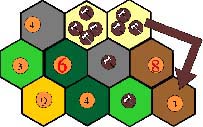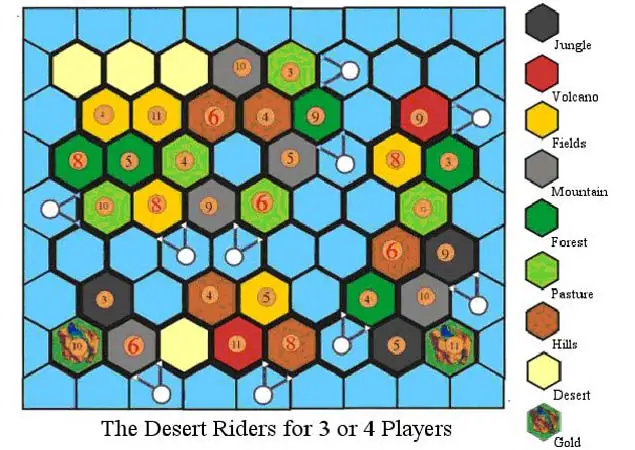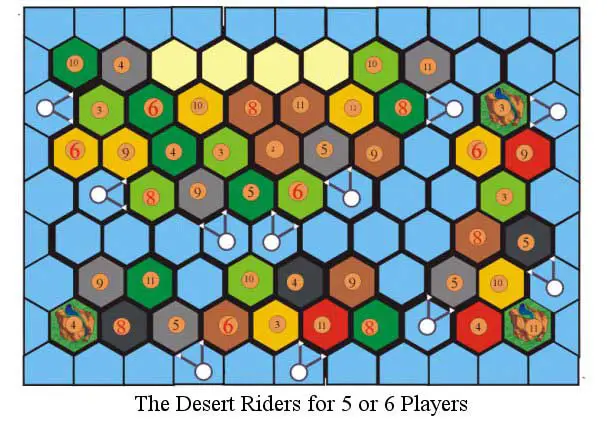
Players: 3-6.
Game Length: 90 to 150 minutes.
Requirements: The Settlers of Catan, The Seafarers of Catan, and additional components listed below.
Object of the Game
Players attempt to settle the mainland and surrounding islands of Catan.
With each new settlement and city constructed, the malevolent Desert Raiders increase their presence on the mainland, overtaking the settlers' structures and stealing their resources.
Setup
Build the board as shown in the illustration. The number of players determines which illustration you should use.
The upper island with the multiple Desert hexes is the Home Island on which players must place their 2 starting settlements. Important: Each player must place their first Settlement along a coast, and must place a Ship instead of a Road extending from this Settlement.
There is no Robber or Pirate in this scenario. When a "7" is rolled, players with more than seven resources must discard half their cards, as usual. The player who rolled the "7" then takes one random card from any other player of his choice.
The "Largest Army" victory point card is not used in this scenario.
The Desert Raiders are set up outside of the playing area. The number of Raiders is dependent upon the number of players:
- Three or Four players: 18 Desert Raiders
- Five or Six players: 24 Desert Raiders
Special Rules
Each time a player builds a Settlement or a City, he must place Desert Raiders onto the mainland Desert hexes of his choice. If there are four or six players, 2 Raiders are placed, for three or five players, place 3. The Raiders should be placed in the middle of the Desert hexes, not on their corners or edges.
When all the Desert Raiders have been placed, the "Storm of the Desert Raiders" beings: Each turn, when the dice are rolled for production, check to see if the Desert Raiders attack a new hex.
If the number rolled matches the number of any hex that borders any other hex with a Desert Raider, take one Desert Raider from any one of the Desert hexes, and place it onto the hex rolled.
Desert Raiders are placed if the hex rolled borders any of the initial Desert hexes, or if it borders any non-Desert hex that a Desert Raider currently occupies. If the number rolled corresponds to two hexes that neighbor Desert Raiders, Desert Raiders are placed in both hexes.

Example: a three has been rolled. The Brick hex with the "3" is neighboring a land hex with a Desert Raider. A Desert Raider will be placed onto the Brick hex from one of the Deserts. The Wool hex with the "3" remains unchanged, as it does not border a hex with a Desert Raider.
The Consequences of Conquest
A Desert Raider blocks resource production from a hex, in the same way as the Robber - adjacent Cities and Settlements no longer produce resources when the number of the occupied hex is rolled. Hexes covered by Desert Raiders do, however, produce resources on the turn that the Desert Raider is first placed in that hex.
Roads that lie between two hexes that are covered by Desert Raiders are rotated 90 degrees. These roads are cancelled.
As soon as Desert Raiders surround a City or Settlement so that resources can not be drawn from any of its neighboring land hexes, the structure is taken by the Desert Raiders. Show this by placing the City or Settlement piece on its side. This piece no longer counts toward victory point totals.
If the Desert Raiders overtake a player's coastal City or Settlement bordering a harbor, the harbor is no longer available for use.
Ships may be added to existing shipping lines proceeding from a coastal Settlement, even after the Desert Raiders take that settlement.
Desert Raiders may not be placed on Water hexes.
Only one Desert Raider may be placed on each Land hex.
Escape to the Neighboring Islands
To prosper in this scenario it is essential to build a shipping line to the other islands before the Desert Raiders begin their invasion. On the neighboring islands the players will find two new types of terrain: Volcanoes and Jungles.
Volcanoes
Follow the rules listed in the "Volcano" scenario, with the exception that bordering settlements receive a Grain (2 for bordering cities) instead of "gold" when the volcano erupts.
Jungles
Follow the rules as listed in the "Jungle" scenario.
The Desert Raiders Retreat
It is possible to hinder the Desert Raiders' invasion. When a player plays a Soldier card, he may remove one Desert Raider from a Land hex of his choice and place it in front of him. The Soldier card is placed in the discard pile.
If a Desert Raider was removed from a hex adjacent to a cancelled Road, the Road is turned 90 degrees to its original position and is back in play.
If a Desert Raider was removed from a hex adjacent to a Settlement or City taken by Desert Raiders, the piece is placed upright and is considered back in play.
As long as there are Desert Raiders left on the starting Desert hexes, a hex freed by a Soldier can be retaken by another Desert Raider, if it's number is rolled on the dice.
End of the Game
The first player to earn 13 Victory points on his turn wins the game.
Components and Scenario Maps
The Desert Raiders for three or four players
Components: The basic game, Seafarer expansion
Additional components required: 18 Desert Raider pawns, 8 Number Tiles (3,4,5,6,8,9,10,11), 2 Volcano hexes, 3 Jungle hexes, Discovery tokens.

Hexes
| Sea | Desert | Gold | Fields | Hills | Mntn | Forest | Pasture | Volcano | Jungle | Total |
|---|---|---|---|---|---|---|---|---|---|---|
| 17 | 4 | 2 | 5 | 5 | 5 | 5 | 5 | 2 | 3 | 53 |
Number Chits
| 2 | 3 | 4 | 5 | 6 | 7 | 8 | 9 | 10 | 11 | 12 | Total |
|---|---|---|---|---|---|---|---|---|---|---|---|
| 1 | 3 | 4 | 4 | 4 | 4 | 4 | 4 | 4 | 3 | 1 | 32 |
Number of Ports: 10 (5 Special Ports + 5 "3:1" Ports)
The Desert Raiders for five or six players
Components: The basic game, Seafarer expansion, 5/6 Player Expansion
Additional components required: 26 Desert Raider pawns, 8 Number tiles (3,4,5,6,8,9,10,11), 3 Volcano hexes, 3 Jungle hexes, Discovery tokens

Hexes
| Sea | Desert | Gold | Fields | Hills | Mntn | Forest | Pasture | Volcano | Jungle | Total |
|---|---|---|---|---|---|---|---|---|---|---|
| 19 | 4 | 3 | 7 | 7 | 7 | 7 | 7 | 3 | 3 | 67 |
Number Chits
| 2 | 3 | 4 | 5 | 6 | 7 | 8 | 9 | 10 | 11 | 12 | Total |
|---|---|---|---|---|---|---|---|---|---|---|---|
| 1 | 3 | 4 | 4 | 4 | 4 | 4 | 4 | 4 | 3 | 1 | 32 |
Number of Ports: 11 (5 Special Ports + 6 "3:1" Ports)
Continue Reading


